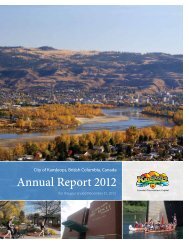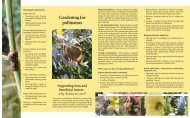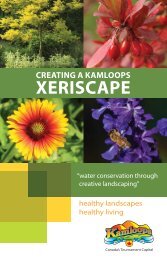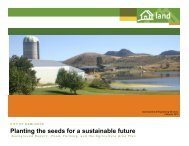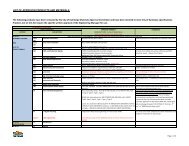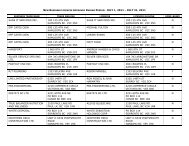PLANT HEALTH CARE - City of Kamloops
PLANT HEALTH CARE - City of Kamloops
PLANT HEALTH CARE - City of Kamloops
You also want an ePaper? Increase the reach of your titles
YUMPU automatically turns print PDFs into web optimized ePapers that Google loves.
<strong>PLANT</strong> <strong>HEALTH</strong> <strong>CARE</strong><br />
have a landscape you<br />
can feel good about...<br />
healthy landscapes<br />
healthy living
Integrated Pest Management<br />
When prevention hasn’t been enough, gardeners use Integrated Pest<br />
Management to deal with pests. It is an approach that takes you through a<br />
process to effectively control weeds, damaging insects or disease, and other<br />
nuisances. Five steps for handling pests are:<br />
Identify:<br />
Identify the plant that is afflicted, then identify whether or not there is a pest.<br />
Often plant damage is more likely to be caused by environmental conditions such<br />
as drought, overwatering, sunscald, frost or wind burn. Then identify the pest.<br />
Make sure you are not looking at a beneficial insect or other natural enemy.<br />
(See the Beneficial Life in Your Garden page to identify friend from foe.)<br />
Monitor:<br />
Make regular inspections or counts, note environmental conditions and keep<br />
records. This helps to make decisions about whether treatments are needed, and<br />
if so, when.<br />
Determine Acceptable Injury Level:<br />
A few aphids on a shrub, or a weed or two in a lawn are not a problem. At some<br />
point though, the numbers could reach an intolerable level. This might be<br />
determined by the pest involved and the location <strong>of</strong> the plant in the landscape.<br />
Healthy landscapes healthy living
Select and Implement Treatment:<br />
In determining what action to take, select methods that are: least<br />
hazardous to human health, least toxic to non target organisms,<br />
least damaging to the environment, most likely to produce longterm<br />
results, and most cost effective over time. Try the following<br />
strategies in this order (or in combination if necessary) and stop<br />
when control is achieved:<br />
• Cultural controls (e.g. growing pest resistant plant varieties)<br />
• Physical controls (e.g. pulling weeds, pruning out infestations, and<br />
installing pest barriers or sticky traps)<br />
• Mechanical (e.g. using machines or devices such as mowers and<br />
line-trimmers)<br />
• Biological (e.g. using natural enemies <strong>of</strong> pests such as ladybugs and birds, or<br />
bacteria such as Btk)<br />
• Chemical (always use the least toxic option and only as a last resort)<br />
Evaluate:<br />
Evaluation is essential since it helps determine what worked, and what didn’t.
Healthy Soil is Alive and Helps Plants Thrive<br />
We all want attractive surroundings, and for those <strong>of</strong> us who have a yard, we also<br />
want it to be a source <strong>of</strong> enjoyment. The best place to start is with soil. Good soil<br />
supports healthy life and is the preferred way to prevent weed growth and deter<br />
insect pests and plant disease.<br />
Plants need soil for support, air, water and nutrients. The important characteristics<br />
<strong>of</strong> soil for growing plants are:<br />
Texture: the relative proportion <strong>of</strong> sand, silt and clay. Most plants do well<br />
in loamy soil containing all three minerals. The soil texture in <strong>Kamloops</strong><br />
varies significantly.<br />
Organic Matter: the non-mineral component <strong>of</strong> soil that was once alive.<br />
<strong>Kamloops</strong> soils are usually low in organic matter.<br />
Soil Life: includes things we can see (earthworms, insects, rodents, reptiles), and<br />
things we can’t (bacteria, fungi, nematodes). Healthy soil is teeming with life - a<br />
handful <strong>of</strong> soil is likely to contain billions <strong>of</strong> organisms and relatively few are<br />
detrimental. Most are necessary for transforming organic matter into nutrients<br />
that can be taken up by your plants.<br />
pH: the measure <strong>of</strong> acidity or alkalinity. Acidic soils are lower than pH 7.0. Alkaline<br />
soils are higher than pH 7.0. A good average range is pH 6.0-7.5. <strong>Kamloops</strong> soils<br />
are usually neutral to alkaline.<br />
Drainage: the rate at which excess water drains from a soil. Sandy soils drain<br />
faster than silt or clay soils.<br />
Salinity: the level <strong>of</strong> potentially harmful salts, usually high in arid areas or poorly<br />
drained soils.<br />
Fertility: the available nutrients for plant growth, generally low in <strong>Kamloops</strong> soil.<br />
Healthy landscapes healthy living
A healthy landscape depends on knowledge <strong>of</strong><br />
your soil conditions. It is recommended you have your soil tested<br />
before making any changes.<br />
The ideal soil depends on what you are trying to grow, as<br />
different plants have different needs. It is easier to grow<br />
something appropriate for your soil type, than it is to significantly change it. Still,<br />
you can make improvements to soil structure and texture, as well as nutrient and<br />
water holding capacity. The goal should be to feed beneficial organisms and deter<br />
harmful ones.<br />
Amendments which can be used to improve soil include:<br />
Organic Material:<br />
compost, aged manure, decomposed sawdust, and peat<br />
moss improve moisture holding capacity in sandy soils<br />
and loosen clay soils.<br />
Sand:<br />
improves drainage in clay soils and the structure <strong>of</strong> light<br />
organic soils.<br />
Lime:<br />
raises the pH <strong>of</strong> acidic soils.<br />
Sulphur:<br />
slightly reduces the pH <strong>of</strong> alkaline soils.<br />
Fertilizer:<br />
adjusts soil nutrients to the requirements <strong>of</strong><br />
proposed plants.<br />
Leaching:<br />
uses water to reduce salinity.
Plant Selection: Right Plant Right Place for the Right Reason<br />
Now that you have the basics <strong>of</strong> soil – a healthy home for plants – you can think<br />
about what you want to put where. Select a variety <strong>of</strong> plants and ensure the right<br />
plant for the right site. Doing so provides an advantage over pest problems.<br />
Consider the following factors:<br />
Water Requirements: In our semi-arid climate, drought tolerant plants thrive<br />
and it shows. There are many beautiful trees, shrubs and flowers with low water<br />
requirements. (See the Creating a <strong>Kamloops</strong> Xeriscape brochure.) Plants adapted to<br />
our climate are usually more pest resistant.<br />
Cold Hardiness: Most plants are given a hardiness rating according to<br />
temperature zones, with Zone 1 being coldest to Zone 8 being the mildest (in<br />
Canada). Our <strong>Kamloops</strong> climate ranges between Zone 3 at its highest levels, to<br />
Zone 6 at the valley bottom. See the zone map on the previous page for details.<br />
Within these zones there are areas known as micro-climates, where the climate<br />
differs from the surrounding area. Hedges, walls, and fencing may <strong>of</strong>fer protection<br />
that can alter growing conditions.<br />
Exposure: Whether an area is sunny or shady, windy or protected, exposure will<br />
determine what plants will flourish where.<br />
Landscape Value: Try to plan for year round interest and enjoyment by<br />
considering more than just flowers. Think about the colour and texture <strong>of</strong> leaves,<br />
bark and fruit, along with overall branching and shape <strong>of</strong> various plants.<br />
Maintenance: Plants vary greatly in the amount <strong>of</strong> care required to keep<br />
them looking attractive. Select plants that realistically meet your gardening<br />
time constraints.<br />
Size: Plant for size, do not prune for size.<br />
Healthy landscapes healthy living
Healthy Ornamental Tree and Shrub Care<br />
Just as a healthy person has a strong immune<br />
system, healthy plants have good defenses. And, just as<br />
thought and care go into maintaining a healthy body, proper<br />
establishment and maintenance <strong>of</strong> a landscape are critical for<br />
its well being. To help build the defenses <strong>of</strong> your landscape and<br />
prevent problems from starting, try the following tips.<br />
Steps for Planting Success<br />
1. Purchase healthy, pest-free plants.<br />
2. When holding plants for later planting, keep them in the shade and water<br />
them regularly.<br />
3. Water plants thoroughly before planting to saturate the root ball with water.<br />
4. When planting a tee or shrub, dig the planting hole two to three times wider<br />
than the root ball.<br />
5. Place the plant in the hole so the top <strong>of</strong> the root ball is level with the<br />
soil surface.<br />
6. Remove any wire or cord from around the stem <strong>of</strong> ball-and-burlap plants. Pull<br />
back or remove the burlap from the root ball if possible. (Exposed burlap will<br />
wick moisture away from the root ball.)<br />
7. Backfill with at least 70% native material and no more than 30%<br />
composted material.<br />
8. Shape a small ring <strong>of</strong> soil along the perimeter <strong>of</strong> the planting hole. This helps<br />
direct water to the roots and prevents run<strong>of</strong>f.<br />
9. Water thoroughly immediately after planting to settle the soil and to eliminate<br />
air pockets that can dry out roots.<br />
10. Apply mulch to the soil surface to conserve moisture, to reduce weeds, and to<br />
regulate soil temperature.<br />
11. Water as necessary during the establishment period. Keep the soil uniformly<br />
moist -- not too wet or too dry. All plants will require more supplemental<br />
watering for the first year or two while they are becoming established.
Healthy Ornamental Tree and Shrub Care (continued)<br />
Mulching:<br />
In nature, plants drop leaves, twigs and branches onto the soil below them. This<br />
layer <strong>of</strong> matter protects plant roots from heat, cold, and drought. It also enriches<br />
the soil and controls weeds. If we mimic nature and apply a layer <strong>of</strong> mulch to the<br />
surface <strong>of</strong> our soil, our landscapes can benefit in the same way.<br />
Depth <strong>of</strong> Mulch: Generally create a layer <strong>of</strong> mulch about 7.5 cm (3”) thick, slightly<br />
less for smaller particles, up to 10 cm (4”) for larger pieces. Too much mulch will<br />
limit the air flow to plant roots, and too little won’t control weeds. To prevent<br />
disease problems, keep mulch away from trunks <strong>of</strong> trees and stems <strong>of</strong> shrubs.<br />
Time to Mulch: It is best to mulch in the spring after the soil has absorbed winter<br />
moisture, but before summer temperatures rise high enough to start pulling the<br />
moisture back out from the soil.<br />
Organic Mulch: Organic mulch must be renewed periodically, as it breaks down<br />
after a period <strong>of</strong> time. It adds nutrients to the soil and improves soil structure<br />
as it decays. (See Weeding section about landscape fabric.) Types <strong>of</strong> organic<br />
mulch include:<br />
• Bark – coarse or fine grades • Grass clippings<br />
• Compost • Shredded newspaper<br />
• Composted sawdust • Wood chips<br />
• Leaf litter – pine needles, shredded leaves<br />
Inorganic Mulch: Inorganic mulch, depending on the colour, can cause<br />
heat buildup in the soil and around plants, which can then increase water<br />
requirements. It should be used carefully for this reason. Avoid plastic or other<br />
impermeable materials which restrict the flow <strong>of</strong> water into the soil. Types <strong>of</strong><br />
inorganic mulch include:<br />
• Crushed gravel • River rock<br />
• Lava rock • Pea gravel<br />
Healthy landscapes healthy living
Watering:<br />
Over-watering contributes to: rapid weak plant growth, fertilizer<br />
leaching, insect and disease problems, and weed growth. To<br />
encourage deep rooting and drought-resistance, water deeply,<br />
thoroughly, and less <strong>of</strong>ten.<br />
• Let soil moisture be your guide for watering frequency. Squeeze a handful<br />
<strong>of</strong> soil, if soil is too dry to form a ball then you’ve waited too long, if it forms<br />
a crumbly ball, it’s time to irrigate. If it forms a ball and is slick, there is no<br />
need to irrigate yet.<br />
• The amount <strong>of</strong> water required for your landscape will depend on<br />
several factors: soil type, weather, location, wind exposure and type <strong>of</strong><br />
plant material. Remember to group together plants with similar water<br />
requirements, and always water lawn separately.<br />
Fertilizing:<br />
Proper fertilizing is an essential component <strong>of</strong> plant health care in the landscape.<br />
There are not always enough nutrients in the soil for a plant to grow well. On<br />
the other hand, excessive fertilizing will promote fast, but weak growth, actually<br />
increase a plant’s water needs and intensifies problems with aphids and other<br />
pests. A soil test will determine if fertilizing is required.<br />
Slow-release fertilizers feed plants from 6-12 months with one application. They<br />
generally cost more than general-purpose fertilizers, however, fewer applications<br />
are required. There are many organic fertilizers to choose from that serve as<br />
soil conditioners – they feed soil organisms and plants. For general-purpose<br />
fertilizers, use light applications for newly planted ornamentals during the first<br />
growing season. When broadcasting fertilizers over the top <strong>of</strong> the foliage, be sure<br />
the foliage is dry, and water soon after application. Follow application guidelines<br />
on the label.
Healthy Ornamental Tree and Shrub Care (continued)<br />
Pest Control:<br />
The best way to control pests is to provide the essentials for good plant growth:<br />
good soil, adequate light, and only the required amounts <strong>of</strong> water. (See Integrated<br />
Pest Management for Your Trees, Plants & Garden)<br />
Pruning:<br />
Proper pruning can keep plants healthy and vigorous. Over-pruning can promote<br />
weak growth and actually increases a plant’s water needs and attracts unwanted<br />
insects. Allowing plants to achieve their natural growth produces a better<br />
appearance and reduces the amount <strong>of</strong> pruning that is necessary.<br />
Why prune:<br />
• To produce more / better blooms<br />
• To rejuvenate older or neglected shrubs – removing overcrowded stems<br />
encourages vigorous new ones<br />
• To remove dead or diseased wood<br />
• To repair injury – damaged wood is an open invitation to<br />
disease-causing organisms<br />
• To train a young plant – encourage balanced open growth<br />
When: There are many variables that dictate the best time to prune. Consider the<br />
following: the condition <strong>of</strong> the plant, the length <strong>of</strong> its growing season, when it<br />
flowers, and whether it blooms on new growth or only on older wood.<br />
How: Use clean, sharp, quality tools suited to the job. Prune back to a branch or<br />
bud, otherwise a stub is left that will die back and promote decay and disease.<br />
Make cuts no more than 64 mm (¼”) above a bud or side branch. Consult pruning<br />
manuals for plant specific requirements.<br />
Healthy landscapes healthy living
Weeding:<br />
Pull weeds as soon as you notice them. It is easier and most<br />
effective when the soil is moist. Try to remove as much <strong>of</strong> the<br />
root system as possible.<br />
Many people look to landscape fabric as a solution; however, it has limited<br />
weed control effectiveness. It is most useful for keeping inorganic mulch from<br />
mixing with the soil. Here are some points to keep in mind if you are considering<br />
landscape fabric:<br />
• It doesn’t allow the spread <strong>of</strong> groundcover plants.<br />
• A layer is created (from decomposing material) that will grow weeds on top<br />
<strong>of</strong> the fabric.<br />
• Fabric prevents decomposed material from mixing with the soil and<br />
enriching it.
Integrated Pest Management for your Trees, Plants and Garden<br />
Step 1<br />
What’s With<br />
My Plant?<br />
Sample local pests<br />
Aphids<br />
Step 2<br />
Monitor<br />
Make regular<br />
inspections / counts<br />
Found on undersides<br />
<strong>of</strong> leaves and on tender<br />
shoots and tips<br />
<strong>of</strong> branches.<br />
Step 3<br />
Tolerance Level<br />
Decide how many are<br />
tolerated<br />
Presence is not<br />
always a problem.<br />
Step 4<br />
Cultural Action<br />
Anything that produces healthy plants<br />
and prevents pest problems<br />
• Encourage flora and fauna<br />
diversity to keep infestations<br />
in check.<br />
Leafrollers<br />
Cherry Fruit Flies<br />
Tent Caterpillars &<br />
Fall Webworms<br />
Green caterpillars that<br />
are usually noticed once<br />
rolled inside leaves. Watch<br />
for them on known host<br />
plants prior to leaf rolling.<br />
Larvae feed on fruit and<br />
overwinter as pupae<br />
in soil.<br />
Hairy caterpillars that spin<br />
silk webbing in branches<br />
and feed on leaves.<br />
Small infestations<br />
are not usually a<br />
risk to ornamental<br />
plant health.<br />
Probably little<br />
tolerance since most<br />
people don’t like<br />
little worms in<br />
their cherries.<br />
Small infestations<br />
are not a risk to<br />
overall plant health.<br />
• Plant resistant varieties<br />
<strong>of</strong> plants.<br />
• Try these ‘companion planting’<br />
techniques:<br />
• Use host plants like<br />
Nasturtiums to attract<br />
predatory insects.<br />
• Use host plants as<br />
traps to distract or<br />
draw pests away. (e.g.<br />
Rose enthusiasts use<br />
Geraniums)<br />
• Use repellent plants<br />
like Marigolds to drive<br />
pests away<br />
• Water adequately.<br />
• Don’t over fertilize. Too much<br />
fertilizer promotes succulent<br />
weak growth that attracts<br />
some pests.<br />
Tomato Hornworms<br />
Large green caterpillars<br />
that consume leaves and<br />
sometimes fruit.<br />
Probably little<br />
tolerance as<br />
caterpillar feeding<br />
can kill young plants.<br />
Powdery Mildew<br />
Fungal disease that<br />
produces white to grayish<br />
powdery growth on a<br />
wide variety <strong>of</strong> plants.<br />
Keep eye out for first signs<br />
– small white powdery<br />
spots on leaves.<br />
Weakens plants<br />
but doesn’t<br />
always kill them.<br />
• Plant resistant varieties.<br />
• Allow good air circulation.<br />
• Avoid excess fertilizer.<br />
Healthy landscapes healthy living
Physical and<br />
Mechanical Action<br />
• Wash <strong>of</strong>f with a strong<br />
stream <strong>of</strong> water<br />
• Scrape egg masses from<br />
branches in winter<br />
• Handpick caterpillars<br />
weekly<br />
Biologicals & Lower-risk<br />
Control Products<br />
• Attract predators<br />
• Spray dormant oil to kill<br />
overwintering eggs<br />
• Try orange zest or<br />
garlic spray<br />
• Attract native parasitic<br />
wasps<br />
• Try a garlic spray<br />
• Apply Btk* to larvae<br />
before leaves roll<br />
Higher-risk<br />
Chemical Control<br />
Products (last resort)<br />
Step 5<br />
Evaluate<br />
• Hang sticky traps<br />
• Pick up and destroy<br />
fallen fruit<br />
• Remove egg masses<br />
from branches in winter<br />
• Prune out infested<br />
sections and destroy.<br />
• Attract natural predators<br />
like ground beetles<br />
• Attract native parasitic<br />
flies and wasps<br />
• Try a garlic spray<br />
• Spray Btk* while larvae<br />
are small<br />
Keep in mind<br />
pesticides are poisons.<br />
They may adversely<br />
affect more than what<br />
you target.<br />
Always wear protective<br />
clothing and never use<br />
near water bodies.<br />
Residents must abide<br />
by any relevant<br />
regulations or<br />
restrictions.<br />
Keeping notes<br />
is helpful in<br />
determining<br />
effectiveness<br />
<strong>of</strong> methods.<br />
• Handpick<br />
• Attract native parasitic<br />
wasps<br />
• Try a garlic spray<br />
• Spray Btk* while<br />
caterpillars are still<br />
small<br />
• Prune <strong>of</strong>f infected parts<br />
and destroy<br />
• Try orange zest, milk, or<br />
garlic spray<br />
* Btk - Bacillus thuringiensis var. kurstaki
Healthy Lawn Care<br />
There’s more than one way for your lawn to be healthy. Reducing or eliminating<br />
pesticides is definitely a healthy option for your family, pets, and neighbours.<br />
However, your lawn itself needs to be healthy and a healthy lawn is achieved by<br />
feeding the soil not the grass. Nourish the soil and most weeds will be crowded<br />
out over time.<br />
Healthy Lawn care tips:<br />
As mowing height decreases,<br />
Mow high: Leave grass 5 - 7 1/2 cm (2-3”) tall<br />
depth <strong>of</strong> rooting decreases<br />
and maintenance increases.<br />
(about a finger length) and avoid mowing more<br />
than 1/3 <strong>of</strong> the grass blade. This shades the<br />
roots and helps prevent evaporation. It also<br />
helps your grass grow deep and strong roots<br />
that can overpower weeds and retain water.<br />
Leaving mulched grass clippings on your lawn can provide about one-third <strong>of</strong><br />
your lawn’s nutrient needs and are a valuable source <strong>of</strong> organic matter.<br />
Dethatch: Thatch is a tough mixture <strong>of</strong> dead grass and roots that accumulate and<br />
form a layer at the soil surface. Excessive watering, nitrogen or pesticides may<br />
contribute to a situation where the thatch exceeds 1 cm (0.4”). Excess thatch can<br />
be removed using a stiff rake or specialized de-thatching equipment.<br />
Aerate: Aeration is the process <strong>of</strong> removing plugs <strong>of</strong> soil from your lawn, or<br />
making holes in it with a tool like a pitch fork. This creates spaces for air, water<br />
and nutrients to penetrate into the soil and promotes the growth <strong>of</strong> beneficial<br />
microorganisms. It also increases water absorption and reduces surface run<strong>of</strong>f.<br />
Topdress: Topdressing involves spreading good quality topsoil or compost on<br />
top <strong>of</strong> your lawn. This adds organic matter and improves the condition <strong>of</strong> the soil.<br />
Topdressing is essential on bare areas and on lawns with little topsoil. Add 0.6 –<br />
1.2 cm (¼ to ½”) <strong>of</strong> topsoil or compost. Don’t smother the grass blades.<br />
Healthy landscapes healthy living
Overseed: Overseeding is the process <strong>of</strong> adding<br />
grass seed to your lawn. Use a high quality mix suited to the area.<br />
Topdressing and seeding can be done together.<br />
Water Deeply: A <strong>Kamloops</strong> lawn doesn’t need to be watered<br />
every other day. It only requires about 2.5 cm (1”) per week to<br />
keep it green. Water one to two days per week depending on weather and soil<br />
conditions (sandy soils drain faster than silt or clay soils). An empty tuna can is<br />
approximately 2.5 cm deep.<br />
• Place several cans at different distances from your sprinkler<br />
• Time how long it takes to collect an average <strong>of</strong> 2.5 cm<br />
• Water this length <strong>of</strong> time about one to two times per week in the summer<br />
• Reduce this time by up to half for spring and fall-time<br />
Try this test to determine when to water for YOUR lawn:<br />
Step on your grass<br />
• If readily bounces back - no watering required<br />
• If it takes awhile to recover - it’s time to water<br />
• If it lies flat - you’ve waited too long<br />
Fertilize: Fertilizing is important to overall grass health and is a very effective<br />
way to prevent weeds. Fertilizing provides the nutrients for a healthy, thick lawn<br />
that out-competes weeds. Choose slow release fertilizers that are much less likely<br />
to ‘burn’ the lawn. Check the package labeling to make sure the product is slow<br />
release and carefully follow the instructions. Steer clear <strong>of</strong> weed and feed and try<br />
feed and seed instead.<br />
Grass alternatives: Many people are recognizing that there are beautiful and<br />
ecologically important alternatives to grass lawns. White Dutch Clover is one<br />
<strong>of</strong> the most popular choices due to its many benefits. For other ideas see the<br />
Creating a <strong>Kamloops</strong> Xeriscape brochure.
Integrated Pest Management for your Lawn<br />
Step 1<br />
What’s With<br />
My Lawn?<br />
Sample local pests<br />
Dandelion<br />
Step 2<br />
Monitor<br />
Make regular<br />
inspections / counts<br />
Counting weeds in<br />
your lawn may simply<br />
involve counting the<br />
number <strong>of</strong> weeds you<br />
step on over a<br />
specific distance.<br />
Step 3<br />
Tolerance Level<br />
Decide how many are<br />
tolerated<br />
Step 4<br />
Cultural Action<br />
Anything that produces<br />
healthy plants and prevents<br />
pest problems<br />
Dandelions grow in<br />
areas with thin grass,<br />
low soil fertility and<br />
as a result <strong>of</strong> low<br />
mowing height.<br />
Decide how many<br />
weeds are tolerated.<br />
• Overseed<br />
• Topdress<br />
• Water<br />
Plantain<br />
Plantain grows in<br />
areas <strong>of</strong> compact soil,<br />
low soil fertility and as<br />
a result <strong>of</strong> low<br />
mowing height.<br />
You may decide<br />
that few weeds<br />
are acceptable in<br />
your highly visible<br />
front yard, but you<br />
may tolerate higher<br />
numbers in the back.<br />
• Aerate<br />
• Fertilize properly<br />
• Raise mower height if<br />
necessary<br />
• Mow before weed goes<br />
to seed<br />
Clover<br />
Clover grows where<br />
soil is compacted and<br />
where soil is low in<br />
nitrogen and high<br />
in phosphorus<br />
Fairy Ring<br />
Fungus that lives on<br />
organic matter and<br />
repels water, causing<br />
drought and resulting<br />
in turf death.<br />
Over-watering and<br />
over-fertilizing cause<br />
thatch, this in turn<br />
contributes to fairy ring.<br />
May have to learn to<br />
live with them as there<br />
is no easy way to get<br />
rid <strong>of</strong> them.<br />
• Dethatch<br />
• Aerate deeply<br />
• Water deeply<br />
• Fertilize correctly to minimize<br />
the differences in grass vigor<br />
between the ring and the rest<br />
<strong>of</strong> the lawn<br />
To prevent spread:<br />
• avoid walking over area<br />
• clean mower after each use<br />
• pick mushrooms and destroy<br />
Healthy landscapes healthy living
Physical and<br />
Mechanical Action<br />
Biologicals & Lower-risk<br />
Control Products<br />
Higher-risk<br />
Chemical Control<br />
Products(last resort)<br />
Step 5<br />
Evaluate<br />
Hand-pull the entire<br />
weed if possible.<br />
Moist soil makes<br />
weeding easier.<br />
Cut <strong>of</strong>f flower<br />
heads before seeds<br />
are dispersed.<br />
Try Corn Gluten Meal<br />
- a by-product <strong>of</strong> corn<br />
that prevents the<br />
germination <strong>of</strong> seeds,<br />
but does not control<br />
established weeds.<br />
Caution: Only use if<br />
grass seed has not<br />
been recently applied.<br />
Try a Vinegar Spray<br />
Caution: Vinegar works<br />
by burning the plant.<br />
Spot spray only as it<br />
will burn grass also.<br />
Keep in mind<br />
pesticides are poisons.<br />
They may adversely<br />
affect more than what<br />
you target.<br />
Resident must abide<br />
by any relevant<br />
regulations or<br />
restrictions.<br />
Keeping notes<br />
is helpful in<br />
determining<br />
effectiveness<br />
<strong>of</strong> methods.<br />
Remove and replace<br />
contaminated soil to a<br />
depth <strong>of</strong> 45cm (18”) and<br />
re-sod or re-seed.<br />
Attempts to control fairy<br />
rings with fungicide<br />
drenches or soil<br />
fumigation have met with<br />
little or no success.
Beneficial Life in your Landscape<br />
Take a few minutes one afternoon, grab a refreshing beverage and sit quietly<br />
in your yard. Watch your plants (this is not like watching paint dry). You may be<br />
amazed at how much life exists there.<br />
Most <strong>of</strong> the insect life you observe (and a lot you can’t even see) is helping your<br />
plants to grow in numerous, unseen ways. In fact, 95-99% <strong>of</strong> all insect species we<br />
encounter are beneficial or harmless to human life or efforts.<br />
Let’s put the insect world aside for the moment and consider other critters that<br />
are helpful. (Some are more lovable than others.) There are birds, bats, toads,<br />
snakes, spiders and earthworms to name a few. The relationship within this<br />
community and with the insect world is mind-boggling.<br />
In nature pests and plant diseases do exist, but rarely get out <strong>of</strong> hand. Problems<br />
start to arise where there is an imbalance. Indiscriminate pesticide use contributes<br />
to imbalance by killing more than the target. We should take our cue from nature<br />
and strive for balance by encouraging biodiversity.<br />
Biodiversity: the presence <strong>of</strong> a diverse collection <strong>of</strong> plants and animals<br />
(flora and fauna).<br />
Invite some wonderful garden helpers over by:<br />
• Avoiding use <strong>of</strong> toxic sprays or dusts as you may end up causing accidental<br />
injury or death to beneficials<br />
• Selecting a variety <strong>of</strong> plants – try using native species<br />
• Planting trees and shrubs for shelter<br />
• Planting a border <strong>of</strong> companion plants rich in pollen and nectar as a food<br />
source for adult stages <strong>of</strong> beneficial insects<br />
• Using a windbreak (e.g. hedge) to reduce dust since beneficial insects<br />
dehydrate easily<br />
• Providing a source <strong>of</strong> water for birds and insects. (Fill a shallow bowl or<br />
birdbath with stones and water so beneficials can<br />
land and drink without drowning).<br />
Healthy landscapes healthy living
Beneficial insects fulfill different roles. There are<br />
four main job descriptions: predator, parasitoid,<br />
pollinator and soil builder/garbage collector.<br />
OUR FRIEND’S THAT PREY ON OUR FOES<br />
Ladybug<br />
Lacewing Hover Fly Parasitic Wasp Dragon Fly<br />
Ladybugs aka Lady-bird beetle<br />
Eat aphids, spider mites, mealy bugs, scale insects<br />
Lacewings<br />
Hover Flies<br />
Parasitic Wasps<br />
Dragon Flies<br />
Nematodes<br />
Beetles<br />
Birds<br />
Spiders<br />
Toads<br />
Bats<br />
Larvae stage eat aphids, whiteflies, leafminers, mites<br />
Larvae prey on aphids, scale insect nymphs, mealy bugs,<br />
thrips, leafhoppers.<br />
Eat whiteflies, aphids and some pest caterpillars<br />
Eat mosquitoes<br />
Microscopic worms that feed on larva & grubs <strong>of</strong><br />
many pests<br />
While some are pests, others are great pest-fighters<br />
Consume insect eggs, beetles and grubs<br />
Help keep insect populations in balance<br />
Can consume 3000 grubs, slugs, beetles and other insects in a<br />
month<br />
Can eat 1000 bugs in one night<br />
Some predatory insects can be purchased to supplement your garden’s<br />
biodiversity. Before ordering be sure to identify the target pest and consult<br />
suppliers for relevant information. Once you receive you hired killers carefully<br />
follow all instructions for handling and releasing.
Integrated Pest Management Calendar<br />
Lawn Care<br />
Late Winter<br />
February to March<br />
• Try to stay <strong>of</strong>f<br />
frozen grass<br />
• If it has been a dry<br />
winter and the ground<br />
is thawing, all plant<br />
material may need a<br />
drink. (lawn, trees,<br />
shrubs, etc.)<br />
Early Spring<br />
Early April to Late April<br />
• Inspect for dead areas and determine<br />
the cause (e.g. Salt, insect, disease)<br />
• Rake to remove debris and brown<br />
patches and compost if insect<br />
and disease free<br />
• Repair areas <strong>of</strong> winter-kill<br />
• Spread grass seed and top-dress entire<br />
lawn with a seed mix suited to sunlight<br />
conditions for each area<br />
• Use lawn aerator to help soil breathe<br />
• Fertilize properly<br />
• Try Corn Gluten meal after snow melts<br />
if you haven’t over-seeded<br />
• Water as needed in the<br />
early morning<br />
• Identify weeds and hand pull<br />
when soil is moist<br />
• Sharpen lawn mower blade<br />
• Confirm mower height is at a minimum<br />
<strong>of</strong> 2, but preferably 3”<br />
Spring<br />
May and June<br />
• Evaluate pest problems and decide<br />
on action<br />
• Hand-pull weeds<br />
• Confirm mower height is at a<br />
minimum <strong>of</strong> 2, but preferably 3”<br />
and cut less than 1/3 <strong>of</strong> the grass<br />
height each time<br />
• Cut lawn before weeds go to seed<br />
• With a mulching capable mower,<br />
leave grass clippings on your lawn<br />
through the growing season – it<br />
saves you one fertilizer application<br />
• Fertilize properly with a summer<br />
fertilizer in June, but it may not be<br />
necessary if lawn is treated with<br />
Corn Gluten, top-dressed or grass<br />
clippings are left<br />
• Water as needed in the<br />
early morning<br />
Garden Care<br />
• Avoid piling snow<br />
containing salt shoveled<br />
from driveways on root<br />
zone <strong>of</strong> shrubs and other<br />
sensitive planted areas<br />
• Plan your coming season<br />
• Don’t forget your<br />
house plants<br />
• Learn about plant<br />
health care<br />
• Learn about integrated<br />
pest management<br />
• Get all your garden<br />
tools ready<br />
• Gradually remove winter protection<br />
• Prune summer flowering shrubs to<br />
improve air circulation and remove<br />
winter kill<br />
• Learn about invasive plants and<br />
noxious weeds<br />
• Learn about composting<br />
• Think about choosing the right plant<br />
for the right spot<br />
• Get pots ready with insect and disease<br />
free soil<br />
• Clean-up perennials<br />
• Add compost and work into soil<br />
• Prune spring flowering shrubs once<br />
blooms are finished<br />
• Plant beds and containers<br />
• Monitor for pests such as<br />
dandelions and aphids<br />
• Start acclimatizing indoor plants for<br />
outdoor use<br />
Tree Care<br />
• Avoid piling snow<br />
containing salt shoveled<br />
from driveways on root<br />
zone <strong>of</strong> trees<br />
• Ensure proper pruning<br />
is used<br />
• Plan an eco-friendly<br />
dormant oil application<br />
• Monitor for pests such as leafrollers<br />
• Good time for planting/transplanting<br />
• Fertilize properly<br />
• Monitor for pests such as tent<br />
caterpillar, tussock moth, and aphids<br />
• Protect trees from construction and<br />
lawn equipment<br />
Healthy landscapes healthy living
Summer<br />
July and August<br />
• Most lawns in <strong>Kamloops</strong><br />
have Kentucky Blue<br />
Grass in the mix<br />
which may naturally<br />
go dormant, turning<br />
brownish<br />
• Monitor for heat stress,<br />
insects and disease and<br />
decide on action<br />
• Hand-pull weeds<br />
• Confirm mower height is<br />
at a minimum <strong>of</strong> 2, but<br />
preferably 3”<br />
• Leave grass clippings on<br />
your lawn<br />
• Water deeply, but<br />
infrequently: 2.5 cm<br />
about 1-2 days per week<br />
Late Summer<br />
Early September<br />
• Confirm mower height is<br />
at a minimum <strong>of</strong> 2, but<br />
preferably 3”<br />
• Leave grass clippings on<br />
your lawn<br />
• Evaluate pest problems<br />
and decide on action<br />
• Aerate lawn<br />
if necessary<br />
• Over-seed and top-dress<br />
entire lawn,<br />
if necessary<br />
• Apply Corn Gluten if not<br />
putting down<br />
grass seed<br />
• Fertilize properly with a<br />
fall/winter fertilizer in<br />
mid to late September<br />
Fall<br />
Late September to November<br />
• Evaluate pest problems<br />
and decide on action<br />
• Hand-pull weeds<br />
• Apply Corn Gluten in<br />
October if grass seed was<br />
used in September<br />
• Mulch your leaves right<br />
into your lawn with<br />
a mulching-capable<br />
mower<br />
• Clean and winterize<br />
lawn equipment<br />
Early Winter<br />
December to January<br />
• Try to stay <strong>of</strong>f<br />
frozen grass<br />
• Remove dead flowers<br />
to encourage longer<br />
and more numerous<br />
flowering and to contain<br />
enthusiastic spreaders<br />
• Add mulch to bare<br />
soil areas<br />
• Monitor for pests such as<br />
black medic<br />
• Water wisely<br />
• Fertilize as needed<br />
• Monitor for weeds and<br />
disease damage<br />
• Any changes wanted<br />
for next year? Never<br />
too early for planning.<br />
Maybe some higher<br />
water use plants could<br />
be replaced by more<br />
drought tolerant ones.<br />
• Divide perennials<br />
• Plant spring bulbs<br />
• Move indoor plants back<br />
in after inspecting for<br />
and managing pests<br />
• Good time for planting<br />
• Leaving leaves in beds<br />
gives winter protection<br />
• Poor performing plants<br />
could be removed<br />
and noted for future<br />
reference<br />
• Winterize your tools<br />
• Shake heavy snow<br />
<strong>of</strong>f plants to prevent<br />
breakage. Plant<br />
wounds invite<br />
pests in.<br />
• Ensure trees, especially<br />
young ones, are watered<br />
adequately<br />
• Monitor for pests such as<br />
fall webworm and aphids<br />
• Fertilize up to the end<br />
<strong>of</strong> July<br />
• Keep monitoring<br />
for pests<br />
• Transplant Evergreens<br />
• Tree roots can be<br />
protected by fallen leaves<br />
• Good time for planting<br />
• Some pruning may<br />
be done<br />
• Clean and sharpen<br />
pruning tools<br />
• Avoid piling snow<br />
containing salt<br />
shoveled from<br />
driveways on root<br />
zone <strong>of</strong> trees
Find out more...<br />
For more information on Integrated Pest Management (IPM), contact:<br />
<strong>City</strong> <strong>of</strong> <strong>Kamloops</strong><br />
Parks, Recreation and Cultural Services<br />
ph: (250) 828-3888 | email: healthylandscapes@kamloops.ca<br />
web: www.kamloops.ca/ipm







